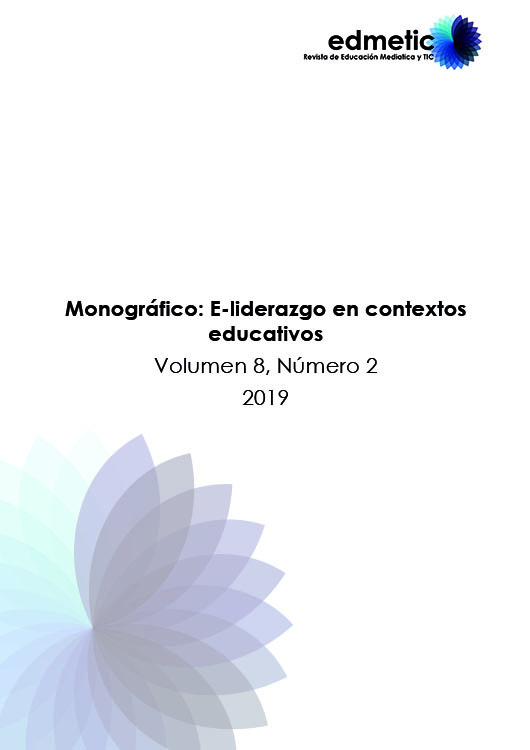Idoneidad didáctica en educación infantil: matemáticas con robots Blue-Bot
Main Article Content
Abstract
Downloads
Article Details
TRANSFER RIGHTS AND COMMITMENTS TO EDMETIC, REVISTA DE EDUCACIÓN MEDIÁTICA Y TIC
E-ISSN: 2254-0059
The undersigned author(s) of article entitled:
- Transfer to EDMETIC, Revista de Educación Mediática y TIC publishing rights of the article mention before. The magazine will have the right to publish in any format or media this article.
- The author(s) claim that this article is original and which has not been published before in any format and wasn´t submitted for evaluation to another publication.
- The author(s) claim that this article has the copyright´s permissions for publication
- The author(s) accept the changes to the contents on the review, and changes in the style of the manuscript by the Editorial Board of EDMETIC, Revista Educación Mediática y TIC.
- The author(s) declare that they have complied with the ethical principles of research.
- The author(s) not be subject to personal or business association that involves a conflict of interest with article presented
- El author(s) undertakes to give the primary sources of information, if requested.
Date:
Author(s) names and signatures (1):
(1) Fill the form and send to: revistaedmetic@uco.es
References
ALSINA, À. (2012). Más allá de los contenidos, los procesos matemáticos en educación Infantil. Edma 0-6: Educación Matemática en la Infancia. 1(1), 1-14.
ALSINA, À. (2014). Procesos matemáticos en Educación Infantil: 50 ideas clave. Números: Revista de la Didáctica de las Matemáticas. 86, 5-28.
ALSINA, À. Y ACOSTA, Y. (2018). Iniciación al álgebra en Educación Infantil a través del pensamiento computacional: una experiencia sobre patrones con robots educativos programables. Unión: Revista Iberoamericana de Educación Matemática, 52, 218-235.
ANTÓN, Á. y GÓMEZ, M. (2016). La geometría a través del arte en Educación Infantil. Enseñanza & Teaching, 34(1), 93-117.
ARNAIZ, V. (2005). Jugant, jugant…L’ofici de créixer. Barcelona: Graó.
BAZÁN, J.L. y APARICIO, A.S. (2006). Las actitudes hacia la Matemática-Estadística dentro de un modelo de aprendizaje. Revista Educación, 15(28), 1-14.
CANALS, M. A. (2009). Transformacions geomètriques. Barcelona: Associació de Mestres Rosa Sensat.
DEL MAR, A. (2006). Planificación de actividades didácticas para la enseñanza y aprendizaje de la ciencia y tecnología a través de la Robótica Pedagógica con enfoque CTS. (Trabajo Especial de Ascenso para optar a la categoría de profesor Asistente). Universidad católica Andrés Bello, Venezuela. Recuperado de: http://biblioteca2.ucab.edu.ve/anexos/biblioteca/marc/texto/AAQ6345.pdf
GALLEGO, E. (2010). Robótica Educativa con Arduino. Una aproximación a la robótica bajo el hardware y software libre. Recuperado de: https://edoc.site/2-robotica-educativa-con-arduino-pdf-free.html
GENERALITAT DE CATALUNYA. DEPARTAMENT D’ENSENYAMENT. (2016). Currículum i orientacions educació infantil: segon cicle. Recuperado de: http://ensenyament.gencat.cat/web/.content/home/departament/publicacions/colleccions/curriculum/curriculum-infantil-2n-cicle.pdf
GODINO, J. D. (2013). Indicadores de idoneidad didáctica de procesos de enseñanza y aprendizaje de las matemáticas. Cuadernos de Investigación y Formación en Educación Matemática, 11, 111-132.
GODINO, J.D. y BATANERO, C. (1994). Significado institucional y personal de los objetos matemáticos. Recherches en Didactique des Mathématiques. 14(3), 325-335.
GODINO, J.D., BATANERO, C., y FONT, V. (2007). The onto-semiotic approach to research in mathematics education. The International Journal on Mathematics Education, 39(1-2), 127-135.
GONZATO, M., FERNÁNDEZ, T., y GODINO, J.D. (2011). Tareas para el desarrollo de habilidades de visualización y orientación espacial. Números: revista de la Didáctica de las Matemáticas, 77, 99-117
HERNÁNDEZ, R., FERNÁNDEZ, C. y BAPTISTA, P. (2014). Metodología de la investigación. (6ª ed.). México: McGrawHill.
MINISTERIO DE EDUCACIÓN (2007). Orden ECI/3960/2007, de 19 de diciembre, por la que se establece el currículo y se regula la ordenación de la Educación Infantil. Madrid: BOE-A-2008. Recuperado de: https://www.boe.es/buscar/doc.php?id=BOE-A-2008-222
NATIONAL ASSOCIATION FOR THE EDUCATION OF YOUNG CHILDREN (NAEYC) y NATIONAL COUNCIL OF TEACHERS OF MATHEMATICS (NCTM). (2013). Edma 0-6: Educación Matemática en la Infancia. 2(1), 1-23.
NATIONAL COUNCIL OF TEACHERS OF MATHEMATICS (NCTM). (2000). Principles and standards for school mathematics. Reston, VA: National Council of teachers of mathematics.
PAPERT, S. (1985). Different visions of logo. Computers in the Schools. Interdisciplinary Journal of Practice, Theory, and Applied Research, 2 (2-3), 3-8.
PITTÍ, K., CURTO, B., y MORENO, V. (2010). Experiencias construccionistas con robótica educativa en el centro internacional de tecnologías avanzadas. Revista Electrónica Teoría de la Educación. Educación y Cultura en la Sociedad de la Información, 11(3), 310-329.
RIVAS, M., GODINO, J.D. y CASTRO, W.F. (2012). Desarrollo del conocimiento para la enseñanza de la proporcionalidad en futuros profesores de primaria. Bolema,26(42B), 559-558.
SANMARTÍ, N. (2007). 10 ideas clave. Evaluar para aprender. Barcelona: Graó.
SULLIVAN, P. y LILBURN, P. (2002). Good questions for Maths Teaching: why ask them and what to ask, K-6. Australia: Oxford University Press.
VALVERDE, J., FERNÁNDEZ, M. R. y GARRIDO, M. C. (2015). El pensamiento computacional y las nuevas ecologías del aprendizaje. RED, Revista de Educación a Distancia, 46(3), 1-18.
YAKMAN, G. y LEE, H. (2012). Exploring the exemplary STEAM education in the U.S. as a practical educational framework for Korea. Journal of the korean Association for Science Education. 32(6), 1072-1086.
